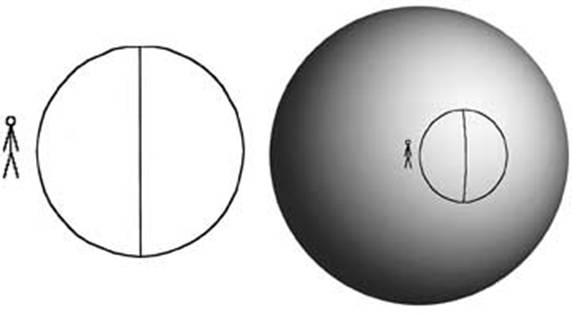A B C
D E F
B. Curvature
So how can space, or spacetime, have a curvature?
What does that mean? There doesn't seem to be anything obviously curved
about either of them.
It helps here to think about some things that obviously are
curved, and see what we can learn from them that we might apply to spacetime.
Consider a basketball. Its surface is clearly not flat like a sheet of
paper or a table top. We could make a sheet of paper more curved, like the
basketball, by wrapping the sheet of paper around the basketball. When we
do, we take the length and width of the sheet of paper and fit them to the
basketball's surface by bending the paper's length and width through a third
dimension. This third dimension is outside the paper surface's
original two.
Likewise, one way to give a curvature to a three- or
four-dimensional continuum like space or spacetime is to bend it through some
additional dimensions, outside the continuum's three or four own dimensions.
This is easy to say, but imagining such a curvature
presents a problem. We live in the three dimensions of space and one
dimension of time, and we lack experience with moving around in additional
similar dimensions. It's not obvious how to visualize extra dimensions
in which spacetime might be curved.
We can, however, understand our situation better by
imagining an analogous problem for a two-dimensional being, living in
two-dimensional space, who can't imagine a third spatial dimension. As
we see in Figure 1, the space wherein he lives might be curved through the
third dimension, or even through fourth, fifth, or additional dimensions, but
he wouldn't be any more able than we are to imagine extra dimensions outside
his space.
On the other hand, if he has the right tools, he could
determine whether his two-dimensional space were curved, even though he
couldn't visualize the curvature directly. One way to do it would
involve his making and surveying a circle.
Suppose this two dimensional person lived in a flat
place. He could pick a point in this place to be the center of a circle,
and make out all the points that were some distance x from this
center to be the circle's circumference. If he then measured the length
of this circumference, and compared it to the length of one of the circle's
diameters, he would find the circumference to be about 3.14159265... times as
long as the diameter-the familiar ratio π.
But
if he tried the same thing in a curved two-dimensional space, he would get a
different result. Suppose his two-dimensional space were the surface of a
very large sphere. The diameter of a circle would be slightly longer than
it would in a plane, since the sphere's curvature would make the circle's
diameter bulge outward a little into the third dimension. Thus the
circle's circumference would be less than times as long as its diameter. The
bigger the circle, the smaller its circumference-to-diameter ratio would
be. With a different kind of curvature, our two-dimensional man would even
find an opposite result. Suppose our man lived in, rather than a spherical
surface, a surface in the shape of a horse's saddle, or the shape of one of
those potato snacks that comes in a tall can. A circle mapped out on a
surface like that would have a circumference more than π times longer than
its diameter, the ratio being greater for a larger circle. In either case,
our two-dimensional surveyor could detect the curvature of his space, and even
determine the general nature and degree of its curvature, just by making
appropriate measurements within his space's own two dimensions. To do so,
he would not have to leave his two-dimensional space, or even be able to imagine
what its curvature would look like in any extra dimensions.

Figure 1. A circle in a flat
plane has a circumference-to-diameter ratio of π
(3.14159265...). On a sphere, a circle's circumference is less than π
times the length of a diameter. A two-dimensional surveyor could thus
detect the curvature of his world even if he couldn't see the third dimension.
We can do something similar in our four-dimensional
spacetime. By making appropriate measurements within spacetime itself, we
should be able to tell whether spacetime has a curvature. The measurements
need not be confined to circles. Einstein's general relativity theory
suggests many different ways that curvature should show up in physical
phenomena. Each of these ways in fact provides a different test of
Einstein's theory. General relativity not only says that spacetime can be
curved, but that it will curve in certain ways, by certain amounts, under
certain circumstances.
The curvature may be as complex as the circumstances that
determine it. The connection between the circumstances and the curvature
was not trivial for Einstein to discover; he had plenty of information to
consider as he figured out the law relating the two, and he didn't understand
everything all at once. Nonetheless, the law he eventually formulated is a
simple one, as is its relation to gravity.
(.....continued)
A
B C D
E F








